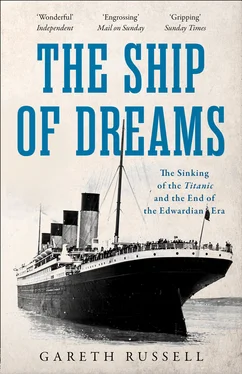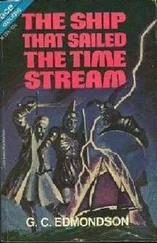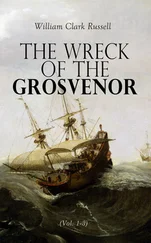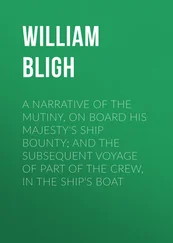The exceptionalism of the Titanic can be rubbished in other ways. On a more macabre note, she was neither the only great seafaring tragedy of the Edwardian era – two years after her, the Empress of Ireland sank following a collision with another ship as she departed Quebec City, with the loss of just over a thousand lives.[6] Nor, arguably, was she the most important. In 1915, the Titanic ’s one-time rival, the Lusitania , foundered off the coast of Ireland with marginally fewer casualties, but far greater and more tangible a political impact. The attack on the Lusitania by the German submarine U-20 irrevocably hardened attitudes towards Imperial Germany in the United States at the height of the First World War, forcing an emergency meeting of the Crown Council in Berlin which effectively altered German naval policy for the next eighteen months and prepared the mood that would bring America into the war against Germany two years later.[7]
However, although the Titanic ’s dreadful allure may be easy to unpick, it is impossible to dispel. There are societies dedicated to the study of the Titanic across the world, along with numerous museums, souvenirs, novels, musicals, children’s cartoons, computer games, television shows and movies. The first Titanic motion picture was produced in the weeks immediately after the sinking, another silent movie was produced in Germany later that same year, and an early ‘talkie’, Atlantic , appeared in 1929, heavily inspired by the sinking but with the ship’s name and appearance altered after the Titanic ’s still-operational owners, the White Star Line, allegedly threatened a lawsuit.[8] A project in the late 1930s between David O. Selznick and Alfred Hitchcock to dramatise the disaster never moved beyond pre-production, with the result that after Atlantic it was another fourteen years before a motion picture that was both filmed in sound and unambiguously about the Titanic appeared.[9]
On 30 April 1943, Josef Goebbels, the Nazi Minister of Propaganda, banned the movie Titanic , the production of which he had initially authorised.[10] Following the outbreak of the Second World War, Goebbels had overseen a series of anti-British costume dramas that were released in Germany and then, despite some concerns about their potential impact, in various Nazi-occupied territories. Titanic proved to be the last of this politicised genre, which had begun with 1940’s Der Fuchs von Glenarvon and 1941’s Mein Leben für Irland , both dramatising the Irish struggle for independence from Britain. They were joined by Ohm Krüger , set during the Boer wars, and by a biographical drama loosely based on the life of Mary, Queen of Scots, with her English kinswoman, Elizabeth I, cast as a villain who was manipulative to the point of depravity. By the time Titanic went into production, American entry into the war on the Allied side had widened the target of these historical didactics, for which the sinking of the Anglo-American Titanic offered seemingly perfect fodder. The allocated budget made Titanic one of the most expensive motion pictures produced thus far in Germany, dozens of naval personnel were transferred from active duty at the front to serve as extras, and the decommissioned German passenger liner Cap Arcona was provided as a set for much of the filming. Prior to the war, the Cap Arcona had been the most luxurious ship to ply the route to South America, sailing from Hamburg to Buenos Aires, but like many vessels she had been removed from commercial service upon the outbreak of hostilities.
Goebbels wanted Titanic to depict Teutonic heroism, to which end a fictional German officer was inserted into the ship’s roster and shown in the final scenes dashing bravely through flooding corridors to rescue trapped children, but the movie was also intended to highlight the corruption of Germany’s enemies. In one particularly memorable scene, showing a dinner during the Titanic ’s voyage, the shipping line’s owner, J. Bruce Ismay, gives a speech to the Dining Saloon boasting of the liner’s record-breaking speed. At his announcement, several American financiers scuttle away from their tables to send telegrams ordering their brokers to buy shares in the White Star Line while, back in the Saloon, the Titanic ’s privileged passengers stand as the ship’s orchestra plays ‘God Save the King’. As a depiction of German perceptions of British arrogance and American greed, the scene had all the subtlety of a sledgehammer – although that, of course, was not the reason Goebbels vetoed his own creation.
Filming had been plagued with difficulties from the start. The director, Herbert Selpin, privately complained about the military extras’ sexual harassment of the actresses, comments that may have widened into criticism of the armed forces. The scriptwriter reported Selpin’s comments to the Gestapo, who had him arrested and imprisoned, at which point Goebbels almost certainly gave the order that Selpin was to be found hanged in his cell, as if from suicide. Certainly, almost nobody believed Selpin had died by his own hand.[11] Back on set, the production costs were spiralling beyond the generous allowance and several Allied bombing raids on nearby towns intermittently disrupted filming. By the time Goebbels saw the movie at a private screening, those bombing raids had helped turn the tide of the war against Nazi Germany and Goebbels was concerned that the scenes of passengers screaming in panic during the evacuation would remind too many moviegoers of their own experiences during the air raids. He also allegedly worried that German civilians might sympathise with the plight of the British and American passengers as they struggled to escape the Titanic , no matter how repugnant their on-screen leaders.[12] Titanic was the last of the anti-British Nazi historical dramas, after which productions shrank as the Reich stuttered towards oblivion.[13]
During the regime’s depraved unravelling, the Cap Arcona was once again pressed into service, this time to move 9,000 people from Nazi Poland, most of them prisoners from local camps. Whether the SS knew that the Cap Arcona had been identified as a target by the Royal Air Force before they herded the prisoners on board and if that was the reason they herded all the prisoners below deck to make sure the British pilots did not cease fire is unclear. According to the fullest modern account of the Cap Arcona ’s career, the surviving evidence suggests that if the British aeroplanes had not turned up as expected to attack the ship the SS would have bombed it themselves and placed the blame on the Allies, the main reason for moving the prisoners on to known targets being the guards’ hopes of destroying living evidence of the existence of the neighbouring concentration camps.[14] As the RAF attacked the ship, small German boats near by evacuated only fleeing camp guards and SS personnel, who were also the only passengers to have been provided with lifebelts. The Cap Arcona burned, capsized and sank with the lost of about 5,000 lives, meaning that the Titanic ’s one-time cinematic stand-in became the first ship to break her record for the greatest loss of life at sea.
Goebbels’ Titanic is one of the least-known if most repellently intriguing interpretations of the Titanic as both a symbol of Anglo-American cooperation and a damning indictment of its elites. Although no subsequent dramatisations of the disaster have mined the depths of national stereotypes seen in the 1943 version, the story of the Titanic ’s owners pushing her to break the record for the fastest crossing of the Atlantic has been replicated ad nauseam. Where Goebbels sought to excoriate, others have sympathised or simply remained fascinated. As a child growing up in Belfast, I heard stories from my great-grandfather, who had seen the Titanic ’s construction and departure from the city and remembered men and women weeping in the streets when the news broke of the sinking. For him, something had shattered, some certainty had vanished, in that moment. He had never seen his father cry before that morning and he did not remember seeing him do so again. Admittedly, many are unimpressed by the allure of the Titanic to its own or subsequent generations. When he edited the memoirs of one of the Titanic ’s surviving crew members, Stewardess Violet Jessop, the late historian John Maxtone-Graham was unmoved by the liner’s appeal, positing, ‘Ostensibly sinkable in life, she has proved positively unsinkable posthumously … My sense is that we should view the vessel as neither symbol nor metaphor but merely an imprudently captained vessel lost at sea. Leave Titanic as she was, one of hundreds of wrecks littering the Atlantic depths.’[15]
Читать дальше












